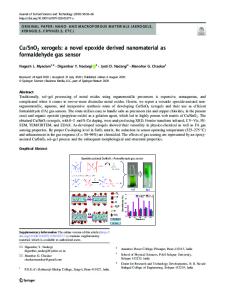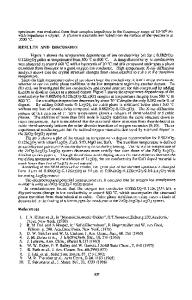Fe 2 O 3 :SnO 2 Nanostructured System as Semiconductor Gas Sensor Material
- PDF / 6,853,725 Bytes
- 6 Pages / 595 x 842 pts (A4) Page_size
- 24 Downloads / 358 Views
A5.15.1
Fe2O3 :SnO2 Nanostructured System as Semiconductor Gas Sensor Material
J. Arbiol 1,2, J. R. Morante 1, M. Rumyantseva 3, V. Kovalenko 3, A. Gaskov 3 1
Enginyeria i Materials Electrònics, Departament d’Electrònica, Universitat de Barcelona, C/. Martí i Franqués, 1, Barcelona, E-08028 (Spain). 2 SCT, Universitat de Barcelona, Lluís Solé i Sabarís, 1-3, Barcelona, E-08028 (Spain). Contact e-mail: [email protected] URL: http://nun97.el.ub.es/~arbiol/ 3
Chemistry Department. Moscow State University, Moscow, Russia
ABSTRACT In the present work, we report a detailed study based on transmission electron microscopy of the microstructure and composition of the Fe2 O3 : SnO2 nanometrical binary system obtained by sol-gel. We studied a set of samples based in a pure Fe2 O3 material where we added SnO 2 from 0 to 50% Sn-Fe nominal content. The structure of our composites will change from pure α-Fe2O 3 to the well-known cassiterite SnO 2 structure for high Sn content. Distortions on the structural parameters will be attributed to the presence Sn4+ ions on the α-Fe2O3 structure and Fe3+ ions on the SnO2 cassiterite structure. INTRODUCTION The introduction of metal or metal oxide additives to nanostructured metal oxides, used as base materials for semiconductor gas sensors, is of great interest due to the influence that they exert on the oxide physical and chemical properties. Moreover, these additives determine the catalytic properties, and the sensitivity and selectivity of the base material on its electrical response under a gas [1]. On the other hand, the presence of these additives have influence on the size and morphology of the generated nanostructures [2, 3], as well as in the formation of new phases and/or binary compounds, which substantially modify the properties of the base material. In this context, the addition of several noble and transition metal oxides to tin oxide has been reported as an essential stage in order to obtain reliable chemical sensors. In the last few years, several authors have reported and demonstrated that materials consisting of Fe2O 3-SnO 2 solid solutions have better gas sensitivities than pure SnO 2 and a-Fe2 O3 compounds [4, 5, 6, 7]. Even, some of these papers postulate that Fe2O 3 on SnO2 was a more effective additive than Pd and Pt, commonly used in gas sensors industry. 8 These Fe2 O3 -SnO 2 solid solutions have been mainly used as alcohol sensors [4, 7, 9], although they also have good sensitivity towards hydrogen, methane and isobutene [4, 5, 8, 9] and even to CO [10, 11]. In the late 90s and early 2000s, most of the works presented, used the mechanical alloying or milling preparation methods in order to obtain their Fe2 O3 -SnO 2 solid solutions [4, 5, 7, 12, 13]. In the early 2000s, some other works presented, used the plasma–enhanced chemical vapor deposition (PECVD) technique to obtain Fe2O 3-SnO 2 thin films [10, 11] The method used in our case will be the well-know sol-gel method, which has been largely used to synthesize pure SnO 2 and Fe2 O3 offering excellent results
Data Loading...










